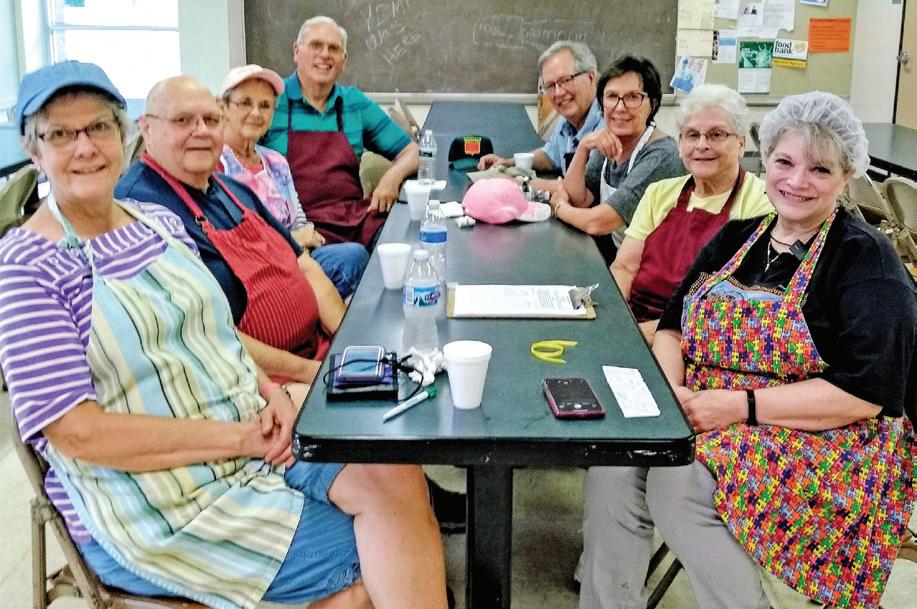
16 minute read
Resistance Is Not Futile
Life-andDeath Lesson Marcel Marceau (Jesse Eisenberg) teaches his charges the power of silence
Second World War movie tells the story of Marcel Marceau’s fight against the Nazis.
by Ken Ramstead
The world knows Marcel Marceau as a legendary mime, internationally renowned for his artistry and skill. He could move audiences to laughter and tears without uttering a single word and was known as the “master of silence.” Marcel received an Emmy award, was declared a “national treasure” by Japan, served as a goodwill ambassador for the United Nations, and was made an officer of France’s Legion of Honour.
But before the acclaim and the accolades, before the performances all over the world, before the numerous honours accorded to him by an admiring public, was a wartime story of heroism and resistance.
On the Run Resistance, fittingly, is the title of the new movie dealing with Marcel Marceau during the Second World War.
Played by Jesse Eisenberg, Marcel Mangel, as he was then, was the son of a Jewish butcher who dreamed of becoming a mime artist, inspired by a Charlie Chaplin movie he had seen as a youngster. Self-centred on his career, Marcel at first refuses to
Photos: Courtesy of IFC Films
help his brother, Alain (Félix Moati), and best friend, Emma (Clémence Poésy), deal with dozens of Jewish immigrant children escaping Nazi Germany. But he soon discovers his humanity while dealing with the refugees, and he uses his pantomime skills to help them forget the horrors they had been through.
With the onset of the Second World War, the fall of France and the eventual German occupation of the entire country, Marcel and his friends realize that resistance is the only way they can make a difference and save the hundreds of children in their care. Marcel and his brother take the last name of Marceau in honour of a general of the French Revolution, all the while eluding the ruthless Gestapo agent Klaus Barbie (Matthias Schweighöfer), known as the Butcher of Lyon.
As part of the French Boy and Girl Scouts, Marcel, Alain and Mila (Vica Kerekes) head to the French Alps with the aim of bringing as many children as they can to the safety of neutral Switzerland.
But with Barbie and a Gestapo death squad hot on their heels, their backs against a deep ravine, will they make it?
In Harm’s Way The experience of the war and the persecution of his fellow Jews brought about a metamorphosis in Marcel Marceau. Thanks to his efforts and working with the French Resistance, as well as the French Boy and Girl Scouts, Marcel was responsible for rescuing hundreds of Jewish children from death at the hands of the Nazis.
Resistance illustrates how one person can make a difference. Had Marcel only continued caring for himself, he might have evaded capture and settled abroad. He chose to put himself in harm’s way and by doing so, saved the lives of hundreds if not thousands of people.
The Apostle Paul said, “Carry each other’s burdens, and in this way you will fulfil the law of Christ” (Galatians 6:2). Sometimes that burden can be as literal as Marcel carrying a tired child on the trek to Switzerland. At other times, it can be as simple as checking on a friend during COVID-19. In either case, a conscious choice is made.
Is that choice in you?
Miming for Life Marcel didn’t just use his mime skills to make the children laugh; he mimed to save their lives. It was a good way of keeping them quiet while they were escaping. “It had nothing to do with show business. He was miming for his life,” Philippe Mora, the son of one of Marceau’s Resistance comrades, told The Age. Resistance is available on most on-demand sources.
Faith&Friends FEATURE
Wonder
Women
FOUR YOUNG STUDENTS WERE WORTH THEIR WEIGHT IN GOLD TO THE CLIENTS OF THE SALVATION ARMY’S NORTH TORONTO COMMUNITY CHURCH. by Linda Dixon

Standing Up for the Community (from left) Phylicia Earl, Jodi Bosley, Folashade Oguntuga and Kyuhee Lee were a dynamic addition to The Salvation Army's North Toronto Community Church this past summer
Photos: Hossein Andarzipour
This past summer, The Salvation Army’s North Toronto Community Church received government funding through the Canada Summer Jobs program for four student placements. Interviewed and carefully chosen by Major Ken and Major (Dr.) Beverley Smith, the co-pastors, the students were assigned to the church’s
community and family services branch.
After initial training in Salvation Army protocols and procedures, they started their summer with us. As North Toronto’s community and family services co-ordinator, I mentored and supervised them, but they all showed a welcome initiative in taking on a project that interested them personally.
Together, these four contributed in ways that not only benefited North Toronto but the wider community that the church serves as well.
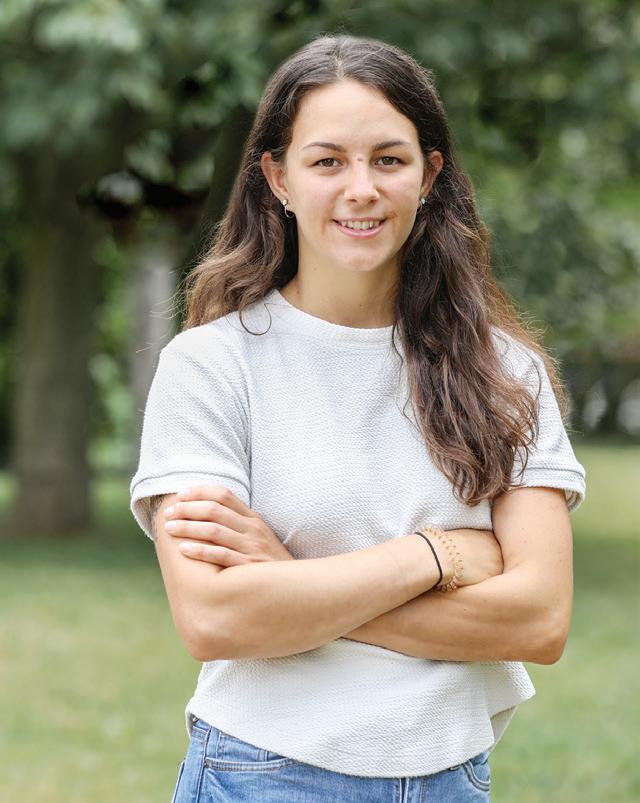
Phylicia Earl This sociology undergraduate entered her first year of a master’s of criminology and social justice studies at Ryerson University in Toronto this past fall.
Smart, kind and intelligent, she was instrumental in developing partnerships with three new local organizations and was able to provide North Toronto’s client community with sought-after products.
As a personal project, Phylicia conducted a study in ways that North Toronto could advance programs and services to greater meet the needs of local women and their families. One mother who participated in Phylicia’s women’s project told her, “The work you’re doing, empowering women, is so important. Thank you!”
Another female client expressed her view of the provision of feminine protection products that Phylicia secured from a generous donor.
“Sometimes feminine protection products are more important than even food,” she told Phylicia.
Jodi Bosley This third-year bachelor of social work student is passionate about social justice issues and art. Another self-starter, Jodi parlayed a routine product inquiry with a supplier into a generous donation to North Toronto of much-needed healthy snack foods for youth and children.
For her personal project, Jodi conducted research on mental illness and how North Toronto might better serve clients facing those significant challenges in life. One client returned especially to say to Jodi, “I
have felt blessed since dropping in yesterday. I’m rejuvenated thanks to the food and shower resources you gave me.”
Another client recommended a friend after his first few tentative visits to North Toronto Community Church.
“I feel safe with you,” he told Jodi. “I don’t like social workers much, but I think you’re going to be a really great one!”
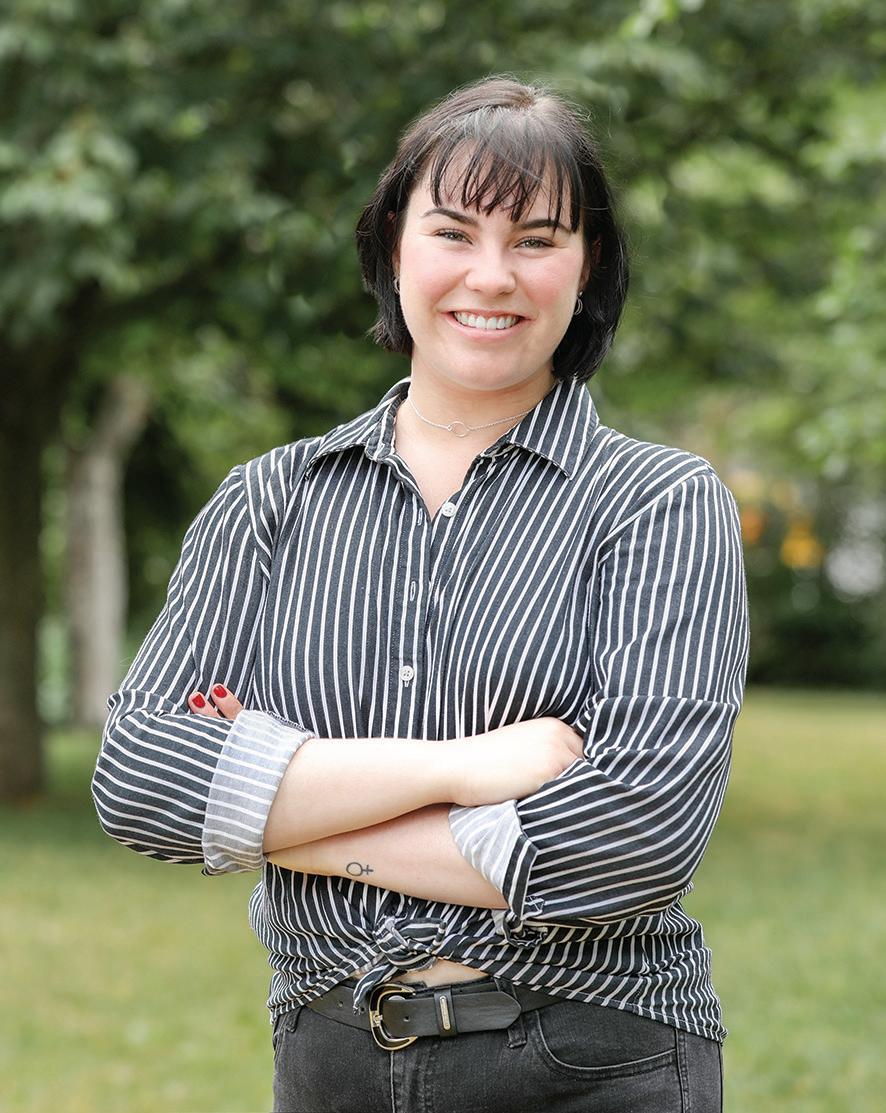
Kyuhee “Liah” Lee This York University master’s student initiated a desperately needed e-contact list for the newly minted North Toronto food bank. As well, Liah contacted, interviewed and vetted applicants, singlehandedly expanding the North Toronto volunteer force to include an impressive roster of capable, energetic and reliable people—all within the constraints of COVID-19.
Over the summer, this resourceful student took on the task of helping various clients in their quest for employment. After helping one newcomer to Canada with her resumé and finding a suitable

volunteer opportunity to help her client gain experience and references, the woman found employment. The client returned to North Toronto to say how grateful she was for the help and support she received from Liah.
Folashade “Sade” Oguntuga Energetic, articulate and innovative, art features prominently in this high school student’s future. With a compassion and understanding of the stresses experienced by youth and exacerbated by COVID-19, Sade created a brochure that provided information and resources on mental health for students.
As a team outreach project, copies were handed out to passersby on a nearby street corner, accompanied by smiles and offers of Skittles.

The outreach was a resounding success. One person scanned the brochure and asked, “Who made this? It’s really cute!” Sade’s co-worker, beaming with pleasure at her teammate’s accomplishment, pointed out the creator by name. Holding up the brochure, the woman called out, “Thank you, Sade!”
(left) Linda Dixon is the community and family services co-ordinator at The Salvation Army’s North Toronto Community Church.

Postwar Joe Knypstra in his new Dutch Army uniform in June 1946
CONCENTRATION CAMP SURVIVOR JOE KNYPSTRA’S FAITH HELPS HIM MAINTAIN A POSITIVE OUTLOOK ON LIFE. by Melanie Eskal
ONE LOOK AT JOE KNYPSTRA
and you wouldn’t believe he’s 100. Even after a century, his memory is still sharp. He remembers the day he immigrated to Canada from Holland in 1954, and even recalls all the names of people he first met when he arrived.
One other thing he remembers very clearly is the Second World War and the two years he spent in a concentration camp in his home country after he was arrested for his involvement in the underground Dutch Resistance.
“It was nothing but torture,” Joe says.
He was 23 years old and a solid 150 pounds when he entered the concentration camp, but weighed just 70 pounds when he left.
Joe recalls the sadistic and often random beatings he and the other prisoners received at the hands of the guards, people being shot if they cried or complained.
“If we were lucky, we got a little bit of coffee—coffee, well water,” he says. “And a little piece of bread. It was black. They said it was made from beans. Tasted terrible, but anything was fine. If we were good, we got a little bit of soup—mostly water.”
He remembers being roused in the middle of the night by guards who would whip prisoners who did not get out of bed fast enough. If they didn’t bleed from the lashings, they would be dunked in a trough full of cold water and scrubbed with hard bristles. Sand would then be rubbed
into the wounds.
“Most of them didn’t make it,” Joe says sadly. “You just took it one day at a time.”
He spent two months in the hospital after being liberated from the concentration camp.
Longevity’s Secret Joe’s first home in Canada was Soda Creek, B.C., working as a farmhand before moving to Vancouver to begin selling dry goods. His time as a merchant took him across the country until he settled in Kaleden, B.C., where he ran a bakery, followed by a butcher’s business, until he retired to Penticton, B.C.
Although he saw the worst of humanity in a concentration camp, Joe maintains a positive outlook on life and jokes about how he doesn’t look a day over 70.
“A lot of people have said to me, ‘By golly, you are looking so good. How come?’
Happy Santa Age has not stopped Joe from encouraging donations to The Salvation Army at Christmas


“I reply, ‘You know, I was 25 years old and was 70 pounds—skin and bone—so all the flesh around me is all new. And my hair is new, so that’s why I look young,’ ” he says with a laugh.
A Century of Progress Salvation Army Majors Lisa and Paul Trickett celebrate with Joe on the occasion of his 100th birthday
But the real secret to longevity, according to Joe, is everything in moderation.
“Doesn’t matter what you do. If you overdo it, you won’t make it.”
Reprinted from Penticton Herald, January 14, 2020
A 15-Year Love Affair Following the closure of their church in 2005, Joe and his wife, Frances, decided to visit a few local houses of worship in their area.
They first stepped through the door of the Penticton Salvation Army Community Church to attend a Valentine’s dinner at the invitation of friends, not knowing that this would lead to a love affair with The Salvation Army.
After familiarizing themselves with the Army’s doctrines and evangelistic method of conducting services, they soon decided that they would like to become full-time members and, following classes, were enrolled as senior soldiers.
Joe immediately became as active in the congregation as he was able and found his calling as an enthusiastic greeter at the front door of the church. He hopes to do this with once again when pandemic restrictions are lifted, and continue to hand out the service bulletins and arrange for individuals to take up the weekly offering alongside him. In addition, up until this past Christmas, Joe’s been a supportive and active bell-ringer on the kettles—dressed, when appropriate, as Santa Claus!
“His doctor has forecast that Joe will live to be over 110,” says John Pettifer, who with his wife, Barbara, has been a close friend. “He’s a most remarkable individual.”
Rising to the Challenge
CANADA’S HEALTH-CARE WORKERS HAVE TACKLED COVID-19 HEAD-ON, AS THESE THREE FRONT-LINE WORKERS CAN ATTEST. by Kimberly McIntyre
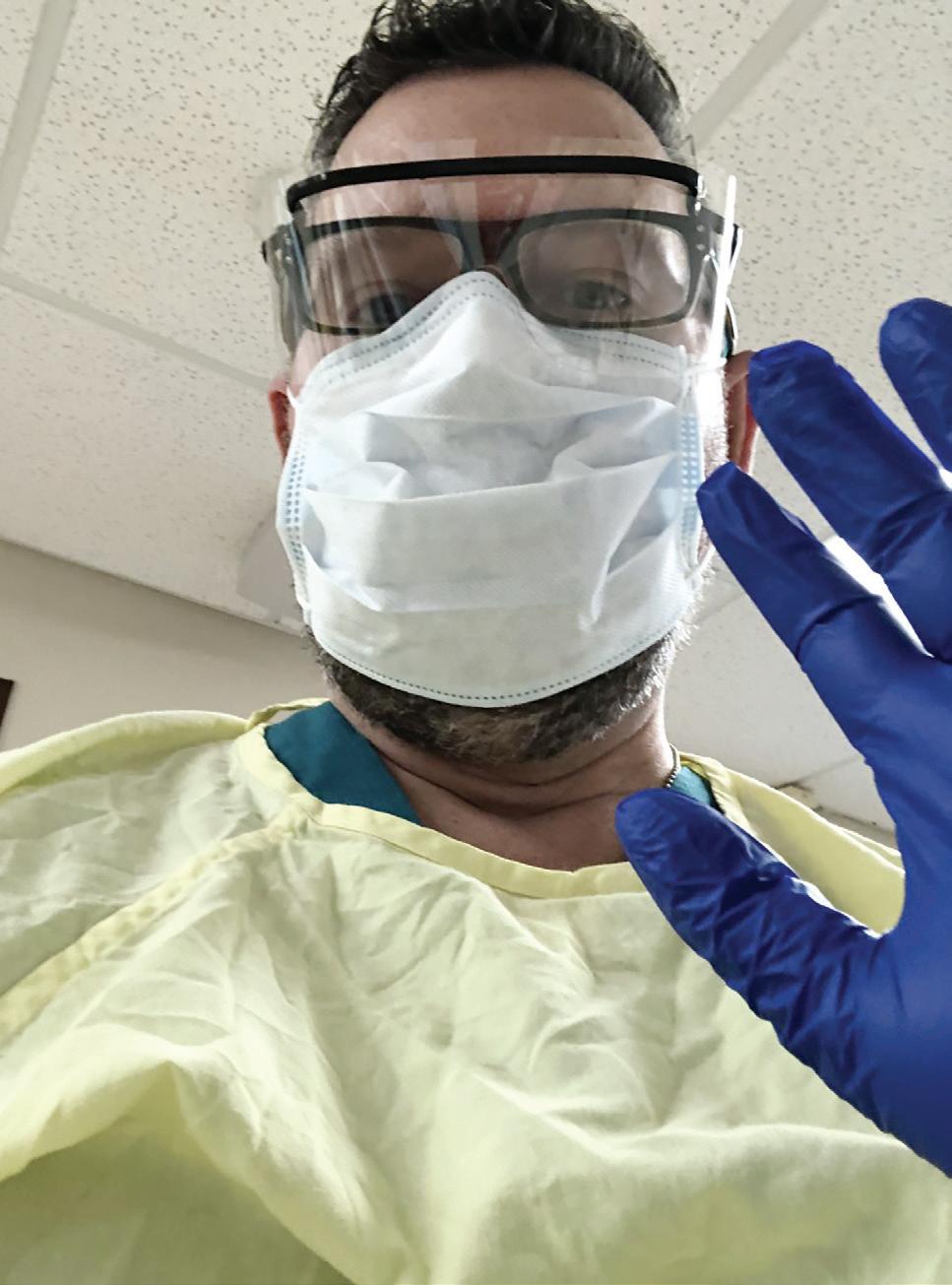
Masked and Ready Jim Moulton ready for duty
As COVID-19 has infiltrated our day-to-day lives over the last several months, many Canadians have had time to reflect on work, priorities and family life. For those in health care, it has been a whirlwind of change. Their call to protect not only themselves and their families but also those in their care has been fundamental in helping to “flatten the curve.” Almost all areas of health care have been affected, and treatment for many looks much different than it did before. Here are three front-line staff working diligently to ensure safe and proper care within the walls of their hospitals.
Right Place, Right Time Jim Moulton, an orthopedic healthcare aide at Grace Hospital in Winnipeg, had his work turned upside down. The patients on his floor were quickly discharged to prepare for COVID-19 cases.
“As we emptied our ward, our staff became the float pool,” he says. “You could be sent anywhere in the hospital when you came to work each day. Totally understandable, but totally stressful. You don’t know the processes or who you are coming into contact with.”
Within the challenges and changes that came with COVID-19, Jim has been reflecting on what led him to health care in the first place.
“I was going through a time of
Conducting Faith Jim is the bandmaster at The Salvation Army’s Heritage Park Temple in Winnipeg
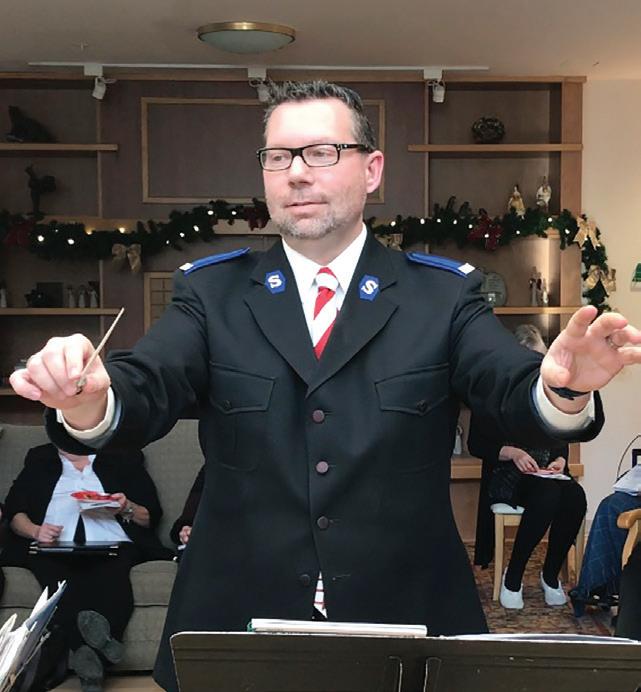
struggle about what I should be doing,” he recalls. “Then I watched as my mother-in-law, who was dying, was taken care of by my sister-in-law, who is a nurse. It impacted my life and I felt a calling to do something with hospice care in particular.”
As COVID-19 progressed, Jim found himself in a full-circle situation.
“Our orthopedic ward started taking very serious patients, some who were dying and in palliative care,” he says. “I was able to really be of use in that way after having 12 years of experience in that area. I was working with non-COVID-19 patients who were in the hospital but were dying alone. That was challenging but affirming. I felt that I was in the right
place at the right time.”
Jim’s faith and Salvation Army church community have been a great support to him.
“I’m a member at Heritage Park Temple and I’m also the bandmaster, so I’m quite involved,” he says. “People have taken the time to send messages and make calls of encouragement to let me know that they were praying and thinking of me.”
“Being There” Donna Lee Samson, a cardiac services manager at St. Boniface Hospital in Winnipeg, was drawn into decision-making for her hospital from the get-go.
“I got a call from my director saying he needed me in the boardroom immediately,” she remembers. “Another manager and I were representing cardiac services at the table for pandemic planning. There were lots of questions, and they called the team together for answers since things were happening rapidly. We didn’t know how patients would present, what patients would bring in and what the needs would be. Each day was consumed with planning, and regular eight-hour days turned into 12-14-hour days while we managed normal flow of the hospital as well as the new information coming in.”
Donna Lee felt the significance of her position as a manager and wanted to do right by her staff.
Leaning on Faith “Faith is about something greater,” says Donna Lee Samson

“I felt that they really looked to me and other managers as if to say, ‘You’ve got my back, right? I can trust you, right?’ ” she says. “I needed to make sure they still felt safe and could still come to work. I still have a job to do, to make sure supports are in place to move forward, no matter what was happening.”
Donna Lee has been leaning on her faith during this time.
“Faith is about something greater,” she says. “It’s all about how you show God’s love and how you live your life. That’s important to me. With the interactions I’ve had with my staff, it’s always a chance to show kindness and compassion as decisions are made. Sometimes it’s just about being there.”
The Advocate Janine van der Horden is an occupational therapist assistant/ physiotherapist at University Health Network-Ontario Rehab in Toronto. She’s seen a shift in mindset around how treatment for the strokerehabilitation patients she cares for is taking place. Normally, a patient would be on track to leave the hospital quickly, then complete recovery in their homes. Now, things are looking very different.
“We normally would have family visiting their loved ones and being involved in the recovery process,” she explains. “We would do caregiver training to teach people what they need to know about caring for a patient in their home. So much of it was hands-on, but then we had to start finding other ways to do that. It’s more of a challenge to make sure our patients are discharged safely and to fill the void that is there because patients don’t have anyone to advocate for them or in-person support from their loved ones.
“Even though right now I have questions, watching people suffer
Peace and Calm “My faith gets me through the day,” says Janine van der Horden
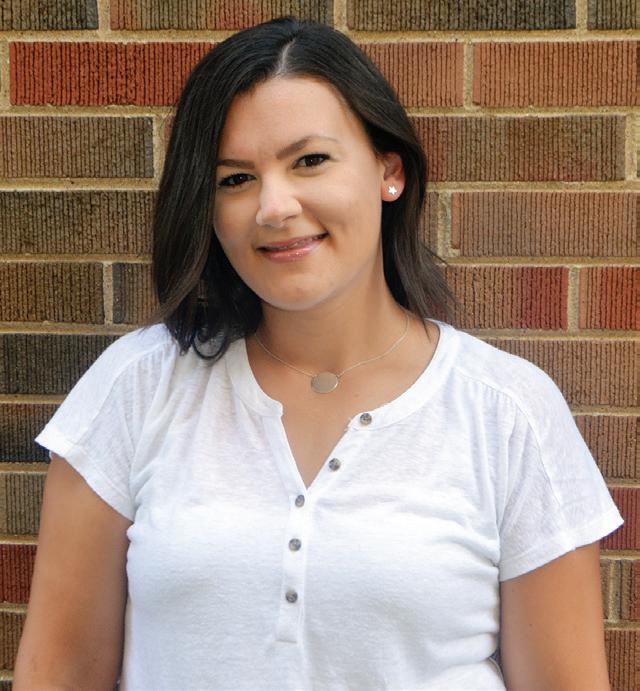
and losing people in my own church family to COVID-19, my faith gets me through the day,” says Janine. “What I get from God is peace and calm. He already knows the outcome, and that, to me, is really hard to imagine. We need to love and be kind to each other, and there are lots of opportunities to show God’s love. My faith keeps me humbled and peaceful.”
(left) Kimberly McIntyre enjoys writing stories of transformation, faith and the human experience. After completing a communications and media degree from Canadian Mennonite University, Kimberly is continuing her education and pursuing a bachelor of science in exercise science. When she is not writing or working in Riding Mountain National Park, she enjoys cooking, exploring Canadian national parks and dancing.

